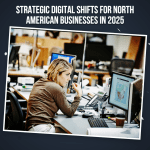Introduction: Precision Retail in the Age of AR
As digital commerce continues to evolve, the emphasis on precision and personalization in customer experience has reached a critical juncture. Among the most transformative advancements is virtual try-on technology, a solution that merges augmented reality (AR), artificial intelligence (AI), and machine learning to enable consumers to visualize products in real time from the comfort of their own homes.
Once considered an emerging trend, virtual try-on has quickly become a strategic imperative for businesses seeking to reduce return rates, elevate customer confidence, and optimize the retail experience. For North American enterprises, particularly those operating within competitive e-commerce and omnichannel environments, this technology offers both a tactical edge and a measurable return on investment.
Understanding Virtual Try-On: Technology That Bridges the Confidence Gap
Virtual try-on technology allows users to superimpose digital renderings of products onto real-time video or still images. By leveraging AR frameworks, 3D modeling, and behavioral data, retailers can offer shoppers the ability to preview eyewear, clothing, furniture, cosmetics, and other consumer goods in situ. This not only enhances visualization but also supports informed decision-making, a critical component in reducing product returns and improving customer satisfaction.
At its core, the technology addresses the longstanding “confidence gap” associated with digital shopping. Consumers often hesitate to make purchases without physically inspecting an item. Virtual try-on closes this gap by offering a realistic simulation of the product’s appearance and fit, eliminating the uncertainty that typically drives hesitation or post-purchase regret.
The Business Case: Quantifiable Impact on Sales and Returns
Recent industry data underscores the value proposition of virtual try-on tools. According to a 2025 CanadianSME report, businesses that implemented AR-based product previewing solutions experienced conversion rate increases of up to 250 percent. These figures are particularly compelling when viewed alongside reductions in product return rates, which remain a persistent cost driver in e-commerce operations.
Reducing returns is not merely a logistical benefit, it is a bottom-line strategy. Returned products require inspection, restocking, potential discounting, and incur additional shipping costs. By providing accurate visual and spatial representations of products before purchase, virtual try-on technology significantly reduces the likelihood of consumer dissatisfaction. In sectors such as apparel and eyewear, where sizing and fit are paramount, this capability becomes even more critical.
Industry Applications: Leading Use Cases Across Retail Sectors
Virtual try-on solutions are already delivering measurable results across multiple verticals, from fashion to home furnishings to health and beauty.
- Eyewear: Brands like Warby Parker have incorporated virtual try-on tools that allow users to see how frames will appear on their face using smartphone cameras. This innovation enhances personalization and reduces the likelihood of ill-fitting selections, leading to both improved user experience and operational efficiency.
- Apparel and Intimates: Retailers such as Knix and Fytted have deployed AI-powered fitting platforms that utilize body scanning and style preference data to recommend accurate sizing and simulate fabric drape. These tools enhance the confidence of online shoppers, mitigating the sizing inconsistencies that plague many fashion retailers.
- Home Furnishings: IKEA’s AR application enables users to place true-to-scale digital furniture into their actual living spaces, thereby testing layout, aesthetics, and scale before making purchasing decisions. This reduces cognitive friction in high-value purchases and supports visual planning in interior design.
- Cosmetics and Personal Care: Cosmetic giants like Sephora and Charlotte Tilbury are leveraging virtual mirrors and live AR previews to allow customers to test makeup looks digitally. These tools bridge the gap between e-commerce and in-store experiences, while also aligning with evolving consumer preferences around hygiene and efficiency.
Technology Infrastructure: What Enables Virtual Try-On?
The implementation of virtual try-on capabilities is driven by several interconnected technologies. Understanding these components is essential for organizations considering integration into their digital infrastructure.
- Augmented Reality (AR): This is the foundational layer that enables the overlay of digital imagery on physical environments. Advanced AR tools now include spatial awareness features, object tracking, and light reflection modeling to improve realism.
- 3D Product Modeling: High-fidelity models allow for precise texture, scale, and color matching. These models are typically created using photogrammetry or CAD and must be optimized for performance across platforms.
- Artificial Intelligence and Machine Learning: AI facilitates intelligent recommendations by analyzing user behavior, facial features, body dimensions, and historical purchase data. These insights support hyper-personalization and more accurate product suggestions.
- Cross-Platform Optimization: Virtual try-on must function seamlessly across operating systems and devices, including mobile browsers, dedicated apps, and desktop interfaces. Responsive design and adaptive performance are critical to maintaining user engagement.
Strategic Benefits for Small and Medium Businesses
While larger enterprises may lead initial adoption, virtual try-on is increasingly accessible to small and medium businesses (SMBs). Off-the-shelf AR integrations, Shopify plugins, and SaaS-based modeling services have democratized access to these tools, allowing retailers with limited technical capacity to leverage them effectively.
For SMBs, the advantages include:
- Differentiation in Competitive Markets: Offering virtual try-on distinguishes smaller retailers from generic catalog-based platforms and positions them as innovative and customer-centric.
- Higher Conversion Rates: By eliminating uncertainty, virtual try-on increases the likelihood of purchase on first engagement.
- Reduced Operational Costs: Lower return rates and improved inventory planning translate directly to savings.
- Data-Driven Insights: Tracking user interactions with virtual try-on tools provides valuable behavioral data that can inform marketing, merchandising, and product development strategies.
The Road Ahead: Integrated, Omnichannel Shopping Journeys
Looking beyond 2025, the trajectory of virtual try-on points toward comprehensive integration within omnichannel retail ecosystems. The goal is not to replace physical shopping but to complement and extend it.
For example, a consumer might try on a dress using a mobile AR interface, receive fit confirmation based on machine learning analysis, and then choose to pick up the product in-store the same day. Alternatively, a user could test several paint colors virtually, save their favorites, and schedule an in-home consultation with a retail associate who arrives with physical swatches and decor samples.
This kind of fluidity is central to the next generation of retail strategy, where in-person and digital interactions are no longer separate silos but elements of a unified, customer-led journey.
Conclusion: A Strategic Imperative, Not a Novelty
Virtual try-on technology is no longer experimental. It is proven, scalable, and increasingly essential. For North American retailers, especially those in the small and medium category, the decision to implement AR-based product visualization tools is not merely about keeping pace with innovation, it is about aligning with consumer expectations and operational efficiency in an increasingly competitive digital marketplace.
In an environment where convenience, confidence, and personalization are paramount, virtual try-on delivers on all three. Its impact extends from marketing to fulfillment and from first-click engagement to long-term customer loyalty.
For businesses that prioritize strategic foresight and consumer-centric design, virtual try-on represents more than a feature. It is a foundational element of future-ready retail.








